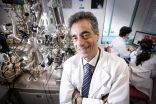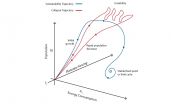Researchers develop new model to study epidemics
Pioneering work at NYU School of Engineering examines the link between individuals and contagion to predict whom to vaccinate or isolate
2014-11-06
(Press-News.org) For decades, scientists have been perfecting models of how contagions spread, but newly published research takes the first steps into building a model that includes the loop linking individual human behavior and the behavior of the epidemic itself.
The first results of the highly complex modeling led by researchers at the New York University Polytechnic School of Engineering were recently spotlighted as "brilliant research" by the American Physical Society.
Eventually, the team hopes the model will more accurately predict who should be vaccinated and isolated first and what travel restrictions will be most effective in preventing different epidemics. The speed of mass communication and modern travel requires changes to most current models. Even underdeveloped countries now have electronic devices that quickly spread the word about diseases and airplanes can carry the infected everywhere nearly as quickly, explained Alessandro Rizzo, visiting professor of mechanical engineering and a leader of the research effort. Modeling thus must be improved by accounting for contagions that spread more slowly than travelers and ones that spread more quickly.
The new model also takes into consideration the differing rates at which the infected and those who merely fear infection react and thereby spread disease. For example, prior work by other researchers indicates that symptomatic people will often self-isolate and--not surprisingly--that the actions of the infected are more relevant to the spread of an epidemic than those of healthy individuals who are avoiding a contagious area. But in some kinds of epidemics, ill people who are asymptomatic behave as if they are healthy, selfishly infecting others. The new model seeks to account for these individual reactions and more. The research team expects that a fully tested and working model is several years away.
The paper, "Effect of Individual Behavior on Epidemic Spreading in Activity-Driven Networks," was authored by Rizzo; NYU School of Engineering Mechanical Engineering, Professor Maurizio Porfiri; and Mattia Frasca of Università degli Studi di Catania, Italy. Rizzo is also a tenured researcher of Politecnico di Bari, Italy. The authors acknowledged the contributions of Dr. Biagio Pedalino, M.D., resident advisor in the U.S. Center for Disease Control and Prevention's Morocco Field Epidemiology Training Program of the Center for Global Health. The paper was published in Physical Review E: http://journals.aps.org/pre/abstract/10.1103/PhysRevE.90.042801. The National Science Foundation supported the research and the Honors Center of Italian Universities provided indirect support.
A second set of research findings, also published in Physical Review E, advances modeling to account for differing probability levels of spreading contagion that arise from infected agents travelling between zones.
The researchers suggested ways to calculate factors affecting the onset of contagion, including the mixing of these contagious people in the population, the contagiousness of the disease, recovery rates, and the geography of the areas. Travel by infected agents was found to be a particular trigger to launching a disease to the level of an epidemic.
INFORMATION:
Rizzo authored the paper with collaborators Arturo Buscarino and Mattia Frasca of the Università degli Sudi di Catania, Italy. Their paper, "Local and Global Epidemic Outbreaks in Populations Moving in Inhomogeneous Environments," is at http://journals.aps.org/pre/abstract/10.1103/PhysRevE.90.042813#s4.
The NYU Polytechnic School of Engineering dates to 1854, when the NYU School of Civil Engineering and Architecture as well as the Brooklyn Collegiate and Polytechnic Institute (widely known as Brooklyn Poly) were founded. Their successor institutions merged in January 2014 to create a comprehensive school of education and research in engineering and applied sciences, rooted in a tradition of invention, innovation and entrepreneurship. In addition to programs at its main campus in downtown Brooklyn, it is closely connected to engineering programs in NYU Abu Dhabi and NYU Shanghai, and it operates business incubators in downtown Manhattan and Brooklyn. For more information, visit http://engineering.nyu.edu.
ELSE PRESS RELEASES FROM THIS DATE:
2014-11-06
By combining projections of climate change, emissions reductions and changes in land use across the USA, an international research team estimate that by 2050, cumulative exposure to ozone during the summer will be high enough to damage vegetation.
Although the research findings - published in Atmospheric Chemistry and Physics Discussions - focus on the impact in the USA, they raise wider concerns for global air quality, according to lead researcher Dr Maria Val Martin, from the University of Sheffield's Faculty of Engineering
"Modelling future air quality is very complex, ...
2014-11-06
The dreaded scratch or puncture test is the most common way of assessing allergic reactions to as many as 40 different substances at once. But because the test involves needles that prick multiple points along the skin's surface, it's a particularly high-stress examination for children -- and their understandably anxious parents.
A new study by Tel Aviv University researchers provides the first quantitative analysis of the role of "medical clowns" in assuaging the anxiety and pain felt by children undergoing allergy tests. The research, published in Allergy, was conducted ...
2014-11-06
Far too many "teachable moments" are lost in a doctor's office during which young adults with hypertension could have learned how to reduce their blood pressure. In fact, only one in every two hypertensive young Americans does in fact receive such advice and guidance from a healthcare provider within a year from being diagnosed, says Heather M. Johnson of the University of Wisconsin School of Medicine and Public Health in the US. She led a study which examined how regularly such education is provided and documented by one of the ten largest physician practice groups in ...
2014-11-06
A major new Series on health and ageing, published in The Lancet, warns that unless health systems find effective strategies to address the problems faced by an ageing world population, the growing burden of chronic disease will greatly affect the quality of life of older people. As people across the world live longer, soaring levels of chronic illness and diminished wellbeing are poised to become a major global public health challenge.
Worldwide, life expectancy of older people continues to rise. By 2020, for the first time in history, the number of people aged 60 years ...
2014-11-06
A car powered by its own body panels could soon be driving on our roads after a breakthrough in nanotechnology research by a QUT team.
Researchers have developed lightweight "supercapacitors" that can be combined with regular batteries to dramatically boost the power of an electric car.
The discovery was made by Postdoctoral Research Fellow Dr Jinzhang Liu, Professor Nunzio Motta and PhD researcher Marco Notarianni, from QUT's Science and Engineering Faculty - Institute for Future Environments, and PhD researcher Francesca Mirri and Professor Matteo Pasquali, from Rice ...
2014-11-06
Toronto, ON - For most cancer patients, primary tumours are often not the most deadly. Instead, it is the metastatic tumours - tumours that spread from their original location to other parts of the body - that are the cause of most cancer deaths.
The catalysts behind the formation of these deadly metastatic tumours are believed to be cancer cells that are launched into the bloodstream from the original site of the cancer. Researchers are very interested in leveraging these circulating tumour cells, or CTCs, which have the potential to allow the properties of a tumour ...
2014-11-06
The NASA/ESA Hubble Space Telescope has snapped a striking view of a multiple star system called XZ Tauri, its neighbour HL Tauri, and several nearby young stellar objects. XZ Tauri is blowing a hot bubble of gas into the surrounding space, which is filled with bright and beautiful clumps that are emitting strong winds and jets. These objects illuminate the region, creating a truly dramatic scene.
This dark and ominous landscape is located some 450 light-years away in the constellation of Taurus The Bull). It lies in the north-eastern part of a large, dark cloud known ...
2014-11-06
Engineers at the University of California, San Diego, are proposing a new surgical intervention for children born with a single ventricle in their heart--instead of the usual two. The new approach would potentially reduce the number of surgeries the patients have to undergo in the first six months of life from two to just one. If successful, it would also create a more stable circuit for blood to flow from the heart to the lungs and the rest of the body within the first days and months of life.
Engineers ran computer simulations of the surgery and found it would reduce ...
2014-11-06
Scientists at Helmholtz Zentrum München (HMGU), at Karolinska Institutet (KI), Stockholm and the University College London investigated the function of ciliary cell extensions in the pancreas. Stimulation of the insulin-producing beta cells increases the number of insulin receptors on their cilia. The cilia consequently play an important role in the release and signal transduction of insulin, a hormone that reduces sugar levels.
Defective cilia lead to elevated blood sugar levels and lowered insulin release
The lead author of the paper Dr. Jantje Gerdes, formerly ...
2014-11-06
Human-caused climate change, ocean acidification and species extinctions may eventually threaten the collapse of civilization, according to some scientists, while other people argue that for political or economic reasons we should allow industrial development to continue without restrictions.
In a new paper, two astrophysicists argue that these questions may soon be resolvable scientifically, thanks to new data about the Earth and about other planets in our galaxy, and by combining the earth-based science of sustainability with the space-oriented field of astrobiology.
"We ...
LAST 30 PRESS RELEASES:
[Press-News.org] Researchers develop new model to study epidemics
Pioneering work at NYU School of Engineering examines the link between individuals and contagion to predict whom to vaccinate or isolate



